Coach (bus)
A coach is a bus used for longer-distance service, in contrast to transit buses that are typically used within a single metropolitan region. Often used for touring, intercity, and international bus service, coaches are also used for private charter for various purposes.
.jpg)
Deriving the name from horse-drawn carriages and stagecoaches that carried passengers, luggage, and mail, modern motor coaches are almost always high-floor buses, with a separate luggage hold mounted below the passenger compartment. In contrast to transit buses, motor coaches typically feature forward-facing seating, with no provision for standing. Other accommodations may include on-board restrooms, televisions, and overhead luggage space.
History
Background
Horse-drawn chariots and carriages ("coaches") were used by the wealthy and powerful where the roads were of a high enough standard from possibly 3000 BC. In Hungary, during the reign of King Matthias Corvinus in the 15th century, the wheelwrights of Kocs began to build a horse-drawn vehicle with steel-spring suspension. This "cart of Kocs" as the Hungarians called it (Hungarian: kocsi szekér) soon became popular all over Europe. The imperial post service employed the first horse-drawn mail coaches in Europe since Roman times in 1650, and as they started in the town of Kocs, the use of these mail coaches gave rise to the term "coach".[1] Stagecoaches (drawn by horses) were used for transport between cities from about 1500 in Great Britain until displaced by the arrival of the railways.[2]
One of the earliest motorised vehicles was the charabanc, which was used for short journeys and excursions until the early years of the 20th century. The first "motor coaches" were purchased by operators of those horse-drawn vehicles in the early 20th century[3] by operators such as Royal Blue Coach Services, who purchased their first charabanc in 1913[4] and were running 72 coaches by 1926.[5]
Features
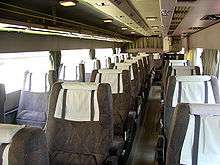
Coaches, as they hold passengers for significant periods of time on long journeys, are designed for comfort. They vary considerably in quality from country to country and within countries. Higher specification vehicles include luxury seats and air conditioning. Coaches typically have only a single, narrow door, but sometimes they have two doors, as an increased loading time is acceptable due to infrequent stops. Some characteristics include:
- Comfortable seats that may include a folding table, armrests, and recliner. Comfort is considered to be an important feature in coaches.[6]
- Luggage racks above the seats where passengers can access their carry-on baggage during the journey
- Baggage holds, accessed from outside the vehicle, often under the main floor or at the rear, where passengers' luggage can be stowed away from the seating area
- Passenger service units, mounted overhead, on which personal reading lights and air conditioning ducts can be controlled and used by individual passengers with little disturbance to other passengers
- On-board rest rooms fitted with chemical toilets, hand basins and hand sanitizer.
- On some coaches, on-board entertainment including movies may be shown to passengers
- On-board refreshment service or vending machines
- Wheelchair accommodation, possibly including a wheelchair lift for access
- Curtains, useful on overnight services
- Onboard Wi-Fi access
- Onboard AC power
Manufacture
Coaches, like buses, may be fully built by integrated manufacturers, or a separate chassis consisting of only an engine, wheels and basic frame may be delivered to a coachwork factory for a body to be added. A few coaches are built with monocoque bodies without a chassis frame. Integrated manufacturers (most of whom also supply chassis) include Autosan, Scania, Fuso, and Alexander Dennis. Major coachwork providers (some of whom can build their own chassis) include Van Hool, Neoplan, Marcopolo, Irizar, MCI, Prevost, Volvo and Designline.
Regulations
In some European countries following the 1958 type certification treaty, coach (that is vehicle of type M2 or M3) type certification is regulated by regulation number 107 from the UNECE.
Image gallery
Modern coaches
A representative selection of vehicles currently (or recently) in use in different parts of the world.
 Murrays Austral Pacific bodied Scania K113TRBL 14.5 m (47 ft 7 in) Quad-axle coach in Canberra, Australia
Murrays Austral Pacific bodied Scania K113TRBL 14.5 m (47 ft 7 in) Quad-axle coach in Canberra, Australia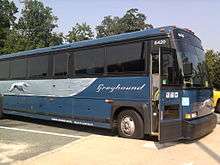 Greyhound Lines MCI 102DL3 in the United States
Greyhound Lines MCI 102DL3 in the United States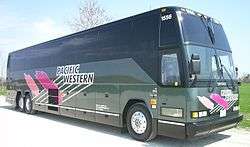 A 56-passenger Prevost coach in Canada
A 56-passenger Prevost coach in Canada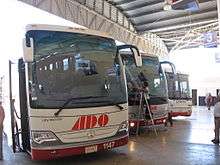
.jpg) Marcopolo Paradiso G7 1800 Double Decker bus
Marcopolo Paradiso G7 1800 Double Decker bus- Divo coachwork from Hispano Carrocera (Tata Motors) on a Mercedes-Benz chassis
.jpg)
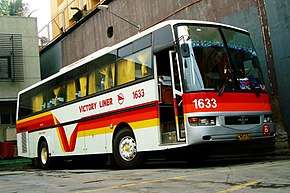 Victory Liner Inc. Provincial Coach (made by Del Monte Motor Works, Inc. on a MAN 16.290 HOCL chassis) (Philippines)
Victory Liner Inc. Provincial Coach (made by Del Monte Motor Works, Inc. on a MAN 16.290 HOCL chassis) (Philippines)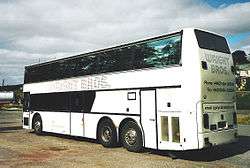
 A double-decker Neoplan Jumbocruiser
A double-decker Neoplan Jumbocruiser- A Hyundai Universe Xpress Noble from 2012
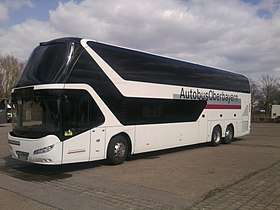
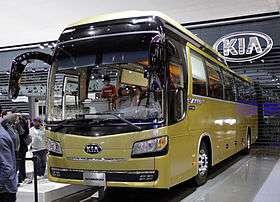 A Kia Granbird Silkroad from 2015 at the Seoul Motor Show
A Kia Granbird Silkroad from 2015 at the Seoul Motor Show Volzhanin-5285 from Russia
Volzhanin-5285 from Russia.jpg) Intercity coach Autosan Lider 9 eco is used also as school coach
Intercity coach Autosan Lider 9 eco is used also as school coach Millennium Luxury Coaches built on a Prevost chassis. Used for leisure.
Millennium Luxury Coaches built on a Prevost chassis. Used for leisure.- Double-decker Neoplans operating the Oxford to London coach route
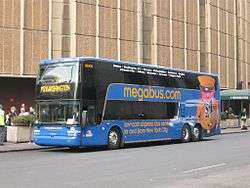
_-_1.jpg)


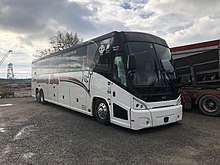 A Barons Bus MCI J4500 from Cleveland, Ohio in Toronto, Ontario - November 2018.
A Barons Bus MCI J4500 from Cleveland, Ohio in Toronto, Ontario - November 2018.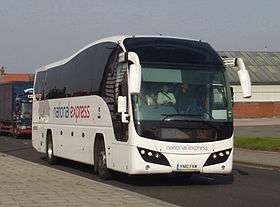 Plaxton-bodied Volvo B9R operated by National Express
Plaxton-bodied Volvo B9R operated by National Express- MAN Lion's coach L
_-_Flickr_-_antoniovera1.jpg) An Irizar i6 built on a MAN chassis
An Irizar i6 built on a MAN chassis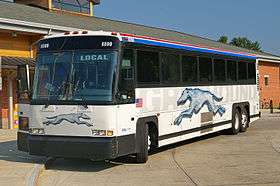 Greyhound Lines MCI 102DL3 Coach bus
Greyhound Lines MCI 102DL3 Coach bus- A Zyle Daewoo Commercial Vehicle BX212 for Sugisaki Kankō Bus, Japan
- An Iveco Bus (Irisbus) Magelys at Busworld 2007
 Setra S 417 HDH in Mannheim
Setra S 417 HDH in Mannheim
Vintage coaches
A selection of vehicles in use in different parts of the world in the past.
- A Leyland Tiger used by Southdown Motor Services in England
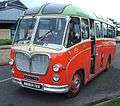 Bedford SB 1961 coach owned by MacBraynes Bus
Bedford SB 1961 coach owned by MacBraynes Bus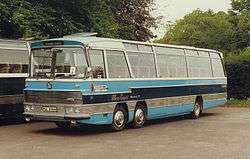
 Short bodied Dennis 1931 King Alfred
Short bodied Dennis 1931 King Alfred Greyhound Lines MCI MC 6 coach built by Motor Coach Industries
Greyhound Lines MCI MC 6 coach built by Motor Coach Industries
See also
References
- Mackay, James (1988). The Guinness Book of Stamps. Guinness Publishing LTD, Enfield, UK. p. 26.
- Dyos, H. J. & Aldcroft, D. H. (1969) British Transport, an economic survey Penguin Books, p. 225.
- W C Standerwick Ltd by Peter Gould
- Anderson & Frankis, p. 28–29.
- Anderson & Frankis, p. 41.
- Cooperative design, visualization, and engineering: third international... By Yuhua Luo, page 141
- Anderson, R. C. A. and Frankis, G. (1970). History of Royal Blue Express Services. David & Charles.
External links
| Wikimedia Commons has media related to Coaches (bus). |
_Arriva_London_New_Routemaster_(19522859218).jpg)